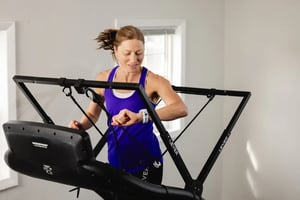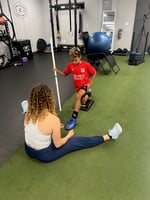Whether it's extreme heat, seasonal storms, schedule constraints, or just needing a mental reset,...
How Treadmill Running Affects Your Form (and How to Avoid Mistakes)
At first glance, running on a treadmill seems like a perfect substitute for outdoor training. But while both involve the same basic movement patterns, there are key differences that affect your running mechanics—often in subtle ways.
The biggest distinction? On a treadmill, the belt moves under you. That means you're not propelling yourself forward in the same way as you would outdoors. As a result, certain muscles (especially in the posterior chain) are less active, and you may rely more on hip flexors and quads than glutes and hamstrings.
READ: Why Your Hamstring Rehab Isn’t Complete Until You Train Speed.
Treadmill surfaces are also flat and consistent, which reduces the need for real-time adjustments in foot placement and balance. That sounds like a positive—until you realize those micro-adjustments are what help build stability, proprioception, and reactive strength when running outside.
Understanding how treadmill running changes your mechanics is the first step toward maintaining strong, efficient form no matter where you're training.
 Common Form Mistakes Runners Make on the Treadmill
Common Form Mistakes Runners Make on the Treadmill
Treadmills offer convenience and control—but they also make it easy to fall into habits that compromise your running form over time. Here are some of the most common mistakes we see:
- Overstriding
Because the belt is moving beneath you, many runners reach too far forward with each step. This not only reduces efficiency but increases braking forces through the knees and hips. - Slouched Posture
Long treadmill sessions often lead to a forward-leaning or hunched posture—especially if you’re staring down at a screen or holding onto the rails. Poor posture limits breathing and affects alignment throughout your stride. - Inconsistent Cadence
Without natural terrain changes or visual cues, cadence (your step rate) often drops on the treadmill. This can lead to heavier landings and increased stress through the lower legs. - Excessive Vertical Bounce
Some runners bounce more on the treadmill because the cushioned surface feels more forgiving. But too much vertical motion wastes energy and can throw off your stride timing.
Each of these habits can slowly chip away at your running efficiency—especially when they’re repeated session after session without correction.
How These Mistakes Impact Running Efficiency
Running efficiency is all about how effectively your body converts energy into forward movement. When form breaks down—whether outside or on a treadmill—you start using more energy for less return. That means slower pace, quicker fatigue, and a higher risk of injury.
Treadmill-specific mistakes like overstriding or bouncing create unnecessary impact and disrupt your natural rhythm. Slouching affects breathing mechanics and core engagement, making it harder to maintain a steady effort over time. And a sluggish cadence can reduce shock absorption, placing more load on joints with every step.
Even small deviations in form, when repeated over miles, can lead to tightness, overuse injuries, and chronic inefficiencies. Over time, runners may notice nagging hip pain, knee stress, or hamstring tightness—all stemming from subtle imbalances that started on the treadmill.
READ: 🏃♂️ How We Use the LEVER Body Weight Support System at Core Values PT (and Why It Works)
At Core Values in Winter Garden, we work with runners to recognize and correct these habits. Whether you're logging miles on the road or the belt, running efficiently helps you go farther, recover faster, and stay injury-free.
Tips to Maintain Proper Form on the Treadmill
Staying efficient on the treadmill takes intention—but with a few simple adjustments, you can keep your form strong and injury-resistant.
- Keep Your Posture Upright
Look straight ahead, not down. Your head, shoulders, and hips should stay aligned, with a slight forward lean from the ankles—not the waist. - Shorten Your Stride
Avoid reaching forward with your feet. Focus on landing with your foot under your center of mass, which promotes better shock absorption and reduces braking forces. - Increase Cadence
Aim for a light, quick turnover—around 170–180 steps per minute for most runners. This helps reduce overstriding and keeps your momentum moving forward. - Use a Slight Incline
Setting the treadmill to a 1% incline mimics outdoor conditions more closely and encourages proper hip extension and muscle activation. - Don’t Hold the Rails
Let your arms swing naturally. Holding on changes your posture and reduces the functional load through your trunk and legs.
These small corrections can make a big difference in how efficient and comfortable your treadmill miles feel.
How Core Values Helps Runners in Winter Garden Run Smarter
Whether you're training indoors for convenience or rehabbing an injury with controlled mileage, running on a treadmill still demands proper mechanics. At Core Values in Winter Garden, we help runners fine-tune their form so they can stay efficient, injury-free, and confident in any setting.
Our Running Physical Therapy and Resilient Runner Program are designed to assess your unique stride and movement patterns—on the treadmill or outdoors. We identify inefficiencies like overstriding, poor posture, or muscle imbalances, then create a personalized plan to improve strength, mobility, and form.
We also incorporate advanced tools like CrossFit Movement Assessments, dry needling, and individualized mobility work to help runners move better and recover smarter. Whether you’re new to the treadmill or returning from a setback, our team is here to guide your progress—step by step.
Efficient running starts with informed movement. If you're in Winter Garden and looking to optimize your treadmill training, Core Values is here to help.



